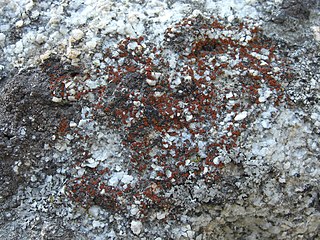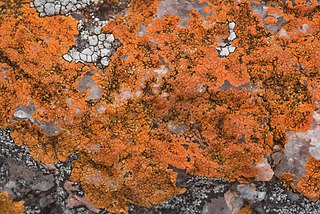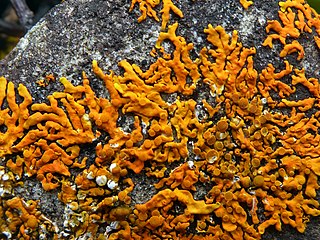
The Teloschistaceae are a large family of mostly lichen-forming fungi belonging to the class Lecanoromycetes in the division Ascomycota. The family has a cosmopolitan distribution, although members occur predominantly in subtropical and temperate regions. Most members are lichens that either live on rock or on bark, but about 40 species are lichenicolous – meaning they are non-lichenised fungi that live on other lichens. Many members of the Teloschistaceae are readily identifiable by their vibrant orange to yellow hue, a result of their frequent anthraquinone content. The presence of these anthraquinone pigments, which confer protection from ultraviolet light, enabled this group to expand from shaded forest habitats to harsher environmental conditions of sunny and arid ecosystems during the Late Cretaceous.

Xanthoria is a genus of lichenized fungi in the family Teloschistaceae. Common names include orange lichen, orange wall lichen, and sunburst lichen. They can be identified by their characteristic squamulose morphology with distinctive "fairy cups".
Fulgogasparrea decipioides is a species of lichen in the family Teloschistaceae. It is found in Gangwon Province, South Korea. This species was originally described in 2011by Ulf Arup as a member of the large genus Caloplaca. The specific epithet decipioides refers to its similarity with Caloplaca decipiens. Arup and colleagues transferred it to genus Wetmoreana in 2013, before it was again transferred to Fulgogasparrea that same year, a genus in which it is the type species.
Cerothallia yorkensis is a species of crustose lichen in the family Teloschistaceae. Found in Australia, where it grows on limestone outcrops, it was described as new to science in 2011. The specific epithet yorkensis refers to the type locality, Yorke Peninsula. It was originally described as a member of the genus Caloplaca, but transferred to Cerothallia in 2013.

Gyalolechia is a genus of lichen-forming fungi belonging to the family Teloschistaceae. It contains 18 species of crustose lichens.

Calogaya is a genus of lichen-forming fungi belonging to the family Teloschistaceae. It has 19 species. The genus was circumscribed in 2013 by Ulf Arup, Ulrik Søchting, and Patrik Frödén. The generic name Calogaya honours Dr. Ester Gaya, a Spanish botanist from the University of Barcelona.

Flavoplaca is a genus of crust-like or scaly lichens in the family Teloschistaceae. It has 28 species with a mostly Northern Hemisphere distribution.

Xanthocarpia is a genus of mostly crustose lichens in the family Teloschistaceae. It has 12 species with a largely Northern Hemisphere distribution.

Rufoplaca is a genus of lichen-forming fungi in the family Teloschistaceae. The genus was circumscribed in 2013 by Ulf Arup, Ulrik Søchting, and Patrik Frödén, with Rufoplaca subpallida assigned as the type species.

Fulgogasparrea is a genus of crustose lichens in the subfamily Xanthorioideae of the family Teloschistaceae. It has five species. The genus was circumscribed in 2013, with Fulgogasparrea decipioides assigned as the type species; this lichen had originally been formally described as a species of Caloplaca, and then a couple of years later transferred to Wetmoreana. Six are credited with authorship of the genus: Sergey Kondratyuk, Jeong Min-hye, Ingvar Kärnefelt, John Alan Elix, Arne Thell, and Jae-Seoun Hur. The genus name alludes to the resemblance of the type species with both of the Teloschistaceae genera Fulgensia and Gasparrinia.

Squamulea is a genus of lichen-forming fungi in the family Teloschistaceae. It has 15 species. The genus was circumscribed in 2013 by Ulf Arup, Ulrik Søchting, and Patrik Frödén, with Squamulea subsoluta assigned as the type species. Five species were included in the original account of the genus. The genus name alludes to the squamulose growth form of most of its species. Squamulea has a worldwide distribution; when the genus was originally created, the centre of distribution was thought to be in southwestern North America.

Dufourea is a genus of mostly foliose lichen species in the subfamily Xanthorioideae of the family Teloschistaceae. Species in the genus are mostly found in the Southern Hemisphere.
Sirenophila is a genus of crustose lichens in the subfamily Teloschistoideae of the family Teloschistaceae. It has four species with an Australasian distribution.
Villophora is a genus of lichen-forming fungi in the subfamily Teloschistoideae of the family Teloschistaceae. It has 9 species. The genus was circumscribed in 2013 by Ulrik Søchting, Ulf Arup, and Patrik Frödén. They assigned Villophora isidioclada as the type, and at that time, only species in the genus. This lichen, previously classified in Caloplaca, is found in South America, Antarctica, and some subantarctic islands. Several additional species were added to the genus in 2021. The generic name Villophora means "carrying filaments".

Wetmoreana is a genus of lichen-forming fungi in the family Teloschistaceae. It has two crustose, saxicolous (rock-dwelling) species.
Gondwania is a genus of lichen-forming fungi in the subfamily Xanthorioideae of the family Teloschistaceae. It has three species. The genus was circumscribed by lichenologists Ulrik Søchting, Patrik Frödén, and Ulf Arup. The type species is G. cribrosa, a species that was first named Polycauliona cribrosa by Auguste-Marie Hue in 1909. The genus name refers to the ancestral supercontinent Gondwana.
Sirenophila gintarasii is a species of lichen in the family Teloschistaceae. Found in Australia, it was formally described as a new species in 2009 by lichenologists Sergey Kondratyuk and Ingvar Kärnefelt, as a member of the genus Caloplaca. The type specimen was collected by the authors from the Camel Rock reserve. There it was found growing on coastal rock outcrops, along with the crustose species Sirenophila eos and Dufourea ligulata, some of which had been deformed by the lichenicolous fungus species Arthonia sytnikii and Pyrenidium actinellum. The species epithet honours Tasmanian lichen lichenologist Gintaras Kantvilas. Ulf Arup and colleagues transferred the taxon to the genus Sirenophila in 2013, following a molecular phylogenetics-based restructuring of the family Teloschistaceae. Sirenophila gintarasii occurs in New South Wales and Victoria.
Sirenophila eos is a species of saxicolous (rock-dwelling), crustose lichen in the family Teloschistaceae. It was first formally described as a new species in 2007 by Sergey Kondratyuk and Ingvar Kärnefelt, as Caloplaca eos. The type specimen was collected from rhyolite outcrops in New South Wales. Ulf Arup and colleagues transferred the taxon to the newly circumscribed genus Sirenophila in 2013, following a molecular phylogenetics-based restructuring of the Teloschistaceae.
Orientophila is a genus of lichen-forming fungi in the family Teloschistaceae. It has 15 species of mostly saxicolous (rock-dwelling), crustose lichens. All Orientophila species occur in Northeast Asia including China, Japan, South Korea, and the Russian Far East.
Cerothallia subluteoalba is a species of corticolous (bark-dwelling), crustose lichen in the family Teloschistaceae. Found in Australia, it was described as a new species in 2009. This species is distinguished by its numerous bright yellow to soft yellow-orange apothecia, tiny spores with slim dividers (septa), and a barely distinguishable thallus that either fades away or grows inside its host.











